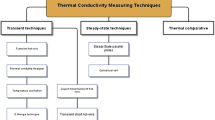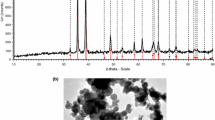Abstract
The thermal conductivity enhancement of CuO-deionized water nanofluids over the deionized water is measured using a tailor-made measurement device that uses the 3-ω technique. The measurement and prediction are carried out for temperatures between 15 and 35°C and volume fractions of 0.025%, 0.05%, and 0.1%. The enhancement in thermal conductivity over the base fluid for the tested conditions is observed to be 13 to 25%. A comparison between the measured data and the predicted ones using established correlations reveals that the deviation in prediction is within ±10%.
Similar content being viewed by others
References
Enhancing Thermal Conductivity of Fluids with Nanoparticles, in Developments and Applications of Non-Newtonian Flows, Choi, S.U.S. et al., Eds., 1995, vol. 231, pp. 99–105.
Das, S.K. et al., Nanofluids: Science and Technology, New Jersey: Wiley, 2007.
Corbino, O.M., Periodic Variation of Resistance of Metallic Filaments on Alternating Current, Attidella Reale Accademia Nazionale de iLincei, 1911, vol. 20, pp. 222–228.
Cahill, D.G., Thermal Conductivity of Thin Films: Measurements and Understanding, J. Vac. Sci. Techn. A, 1989, vol. 7, no. 3, pp. 1259–1266.
Cahill, D.G., Thermal Conductivity Measurement from 30 to 750 K: The 3-Omega Method, Rev. Sci. Instr., 1990, vol. 61, no. 2, pp. 802–808.
Dames, C. and Chen, G., 1ω, 2ω, and 3ω Methods for Measurements of Thermal Properties, Rev. Sci. Instr., 2005, vol. 76, pp. 1–14.
Lu, L. et al., 3ω Method for Specific Heat and Thermal Conductivity Measurements, Rev. Sci. Instr., 2001, vol. 72, pp. 2996–3003.
De Koninck, D., Thermal Conductivity Measurements Using the 3-Omega Technique: Application to Power Harvesting Microsystems, M. Engg. Thesis, 2008, McGill University, Canada.
Oh, D.W. et al., Thermal Conductivity Measurement and Sedimentation Detection of Aluminum Oxide Nanofluids by Using the 3ω Method, Int. J. Heat Fluid Flow, 2008, vol. 29, pp. 1456–1461.
Wang, H. and Sen, M., Analysis of the 3-Omega Method for Thermal Conductivity Measurement, Int. J. Heat Mass Transfer, 2009, vol. 52, pp. 2102–2109.
Karthik, R., Harish, N., Raja, B., and Damodharan, P., Measurement of Thermal Conductivity of Fluids Using 3-ω Method in a Suspended Microwire, J. Eng. Therm., 2012, vol. 21, no. 1, pp. 60–68.
Wang, Z.L. et al., Thermal-Conductivity and Thermal-Diffusivity Measurements of Nanofluids by 3ω Method and Mechanism Analysis of Heat Transport, Int. J. Thermophys., 2007, vol. 28, pp. 1255–1268.
Technical Manual SR-830DSP Lock-in Amplifier-Manual, Stanford Research Systems, 2005.
Wojciechowski, K.T. et al., Application of DLC Layers in 3-Omega Thermal Conductivity Method, J. Achiev. Mater. Manufact. Eng., 2009, vol. 37, pp. 512–517.
Yusibani, E. et al., Application of the Three-Omega Method to Measurement of Thermal Conductivity and Thermal Diffusivity of Hydrogen Gas, Int. J. Thermophys., 2009, vol. 30, pp. 397–415.
Maxwell, J.C., A Treatise on Electricity and Magnetism, 2nd ed., Cambridge: Oxford Univ. Press, 1904, pp. 435–441.
Yu, W. and Choi, S.U.S., The Role of Interfacial Layers in the Enhanced Thermal Conductivity of Nanofluids: A Renovated Hamilton-Crosser Model, J. Nanopart., 2004, vol. 6, pp. 355–361.
Xuan, Y. et al., Aggregation Structure and Thermal Conductivity of Nanofluids, AIChE J., 2003, vol. 49, no. 4, pp. 1038–1043.
Lu, S.Y. and Lin, H.C., Effective Conductivity of Composites Containing Aligned Spheroidal Inclusions of Finite Conductivity, J. Appl. Phys., 1996, vol. 79, pp. 6761–6769.
Koo, J. and Kleinstreuer, C., A New Thermal Conductivity Model for Nanofluids, J. Nanopart. Res., 2004, vol. 6, pp. 577–588.
Prasher, R. et al., Brownian Motion Based Convective-Conductive Model for the Effective Thermal Conductivity of Nanofluids, J. Heat Transfer., 2006, vol. 128, pp. 588–595.
Kumar, D.H. et al., Model for Heat Conduction in Nanofluids, Phys. Rev. Lett., 2004, vol. 93, pp. 1–4.
Keblinski, P. et al., Nanofluids for Thermal Transport, Materials Today, 2005, vol. 8, pp. 36–44.
Author information
Authors and Affiliations
Corresponding author
Rights and permissions
About this article
Cite this article
Karthik, R., Harish Nagarajan, R., Praveen, K.S. et al. Experimental investigation on thermal conductivity enhancement of copper (II) oxide-DI water nanofluids. J. Engin. Thermophys. 23, 341–349 (2014). https://doi.org/10.1134/S1810232814040122
Received:
Published:
Issue Date:
DOI: https://doi.org/10.1134/S1810232814040122




